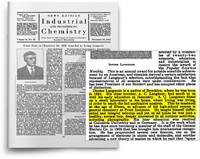Advertisement
Grab your lab coat. Let's get started
Welcome!
Welcome!
Create an account below to get 6 C&EN articles per month, receive newsletters and more - all free.
It seems this is your first time logging in online. Please enter the following information to continue.
As an ACS member you automatically get access to this site. All we need is few more details to create your reading experience.
Not you? Sign in with a different account.
Not you? Sign in with a different account.
ERROR 1
ERROR 1
ERROR 2
ERROR 2
ERROR 2
ERROR 2
ERROR 2
Password and Confirm password must match.
If you have an ACS member number, please enter it here so we can link this account to your membership. (optional)
ERROR 2
ACS values your privacy. By submitting your information, you are gaining access to C&EN and subscribing to our weekly newsletter. We use the information you provide to make your reading experience better, and we will never sell your data to third party members.
People
Ernest Rutherford, Nobel Chemist
October 10, 2011
| A version of this story appeared in
Volume 89, Issue 41
In her Newscripts column, Sarah Everts worried that Ernest Rutherford “would roll over in his grave if I called him a chemist” (C&EN, Aug. 22, page 64). She needn’t have worried.
To a former student at McGill University in Montreal in 1908, Nobel Chemistry Laureate Rutherford wrote, “I must confess it was very unexpected and I am very startled at my metamorphosis into a chemist (Dardo, Mauro. “Nobel Laureates and Twentieth-Century Physics.” Cambridge, England: Cambridge University Press, 2004, page 69). Amused by the irony of the award, in his banquet address of Dec. 11, 1908, he quipped, “I have dealt with many different transformations with various periods of time, but the quickest I have met was my own transformation in one moment from a physicist to a chemist” (Jarlskog, Cecilia, www.slac.stanford.edu/econf/C0805263/ProcContrib/jarlskog_c.pdf).
The 2010 Nobel Prize in Physics presents a similar “crossover effect.” Although it was awarded to two physicists, the prize-winning work involved the chemical species graphene, which received considerable coverage and publicity in popular chemical magazines (Chem. Educator2011,16, 195).
By George B. Kauffman
Fresno, Calif



Join the conversation
Contact the reporter
Submit a Letter to the Editor for publication
Engage with us on Twitter